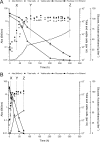Peculiar H⁺ homeostasis of Saccharomyces cerevisiae during the late stages of wine fermentation
- PMID: 22752170
- PMCID: PMC3416607
- DOI: 10.1128/AEM.01355-12
Peculiar H⁺ homeostasis of Saccharomyces cerevisiae during the late stages of wine fermentation
Abstract
Intracellular pH (pH(in)) is a tightly regulated physiological parameter, which controls cell performance in all living systems. The purpose of this work was to evaluate if and how H(+) homeostasis is accomplished by an industrial wine strain of Saccharomyces cerevisiae while fermenting real must under the harsh winery conditions prevalent in the late stages of the fermentation process, in particular low pH and high ethanol concentrations and temperature. Cells grown at 15, 25, and 30°C were harvested in exponential and early and late stationary phases. Intracellular pH remained in the range of 6.0 to 6.4, decreasing significantly only by the end of glucose fermentation, in particular at lower temperatures (pH(in) 5.2 at 15°C), although the cells remained viable and metabolically active. The cell capability of extruding H(+) via H(+)-ATPase and of keeping H(+) out by means of an impermeable membrane were evaluated as potential mechanisms of H(+) homeostasis. At 30°C, H(+) efflux was higher in all stages. The most striking observation was that cells in late stationary phase became almost impermeable to H(+). Even when these cells were challenged with high ethanol concentrations (up to 20%) added in the assay, their permeability to H(+) remained very low, being almost undetectable at 15°C. Comparatively, ethanol significantly increased the H(+) permeability of cells in exponential phase. Understanding the molecular and physiological events underlying yeast H(+) homeostasis at late stages of fermentations may contribute to the development of more robust strains suitable to efficiently produce a high-quality wine.
Figures





Similar articles
-
Ethanol tolerance of sugar transport, and the rectification of stuck wine fermentations.Microbiology (Reading). 2008 Feb;154(Pt 2):422-430. doi: 10.1099/mic.0.2007/011445-0. Microbiology (Reading). 2008. PMID: 18227246
-
Fermentation temperature modulates phosphatidylethanolamine and phosphatidylinositol levels in the cell membrane of Saccharomyces cerevisiae.Appl Environ Microbiol. 2013 Sep;79(17):5345-56. doi: 10.1128/AEM.01144-13. Epub 2013 Jun 28. Appl Environ Microbiol. 2013. PMID: 23811519 Free PMC article.
-
Use of chemostat cultures mimicking different phases of wine fermentations as a tool for quantitative physiological analysis.Microb Cell Fact. 2014 Jun 13;13:85. doi: 10.1186/1475-2859-13-85. Microb Cell Fact. 2014. PMID: 24928139 Free PMC article.
-
Biotechnological impact of stress response on wine yeast.Lett Appl Microbiol. 2017 Feb;64(2):103-110. doi: 10.1111/lam.12677. Epub 2016 Nov 21. Lett Appl Microbiol. 2017. PMID: 27714822 Review.
-
Flor yeasts of Saccharomyces cerevisiae--their ecology, genetics and metabolism.Int J Food Microbiol. 2013 Oct 15;167(2):269-75. doi: 10.1016/j.ijfoodmicro.2013.08.021. Epub 2013 Sep 10. Int J Food Microbiol. 2013. PMID: 24141073 Review.
Cited by
-
Wine Yeast Cells Acquire Resistance to Severe Ethanol Stress and Suppress Insoluble Protein Accumulation during Alcoholic Fermentation.Microbiol Spectr. 2022 Oct 26;10(5):e0090122. doi: 10.1128/spectrum.00901-22. Epub 2022 Aug 30. Microbiol Spectr. 2022. PMID: 36040149 Free PMC article.
-
Monitoring and evaluation of alcoholic fermentation processes using a chemocapacitor sensor array.Sensors (Basel). 2014 Sep 2;14(9):16258-73. doi: 10.3390/s140916258. Sensors (Basel). 2014. PMID: 25184490 Free PMC article.
-
Noninvasive high-throughput single-cell analysis of the intracellular pH of Saccharomyces cerevisiae by ratiometric flow cytometry.Appl Environ Microbiol. 2013 Dec;79(23):7179-87. doi: 10.1128/AEM.02515-13. Epub 2013 Sep 13. Appl Environ Microbiol. 2013. PMID: 24038689 Free PMC article.
-
Downshifting Yeast Dominance: Cell Physiology and Phospholipid Composition Are Altered With Establishment of the [GAR +] Prion in Saccharomyces cerevisiae.Front Microbiol. 2020 Aug 25;11:2011. doi: 10.3389/fmicb.2020.02011. eCollection 2020. Front Microbiol. 2020. PMID: 32983023 Free PMC article.
-
Efficient fermentation of an improved synthetic grape must by enological and laboratory strains of Saccharomyces cerevisiae.AMB Express. 2014 Apr 1;4:16. doi: 10.1186/s13568-014-0016-0. eCollection 2014. AMB Express. 2014. PMID: 24949253 Free PMC article.
References
-
- Aguilera F, Peinado RA, Millán C, Ortega JM, Mauricio JC. 2006. Relationship between ethanol tolerance, H+-ATPase activity and the lipid composition of the plasma membrane in different wine yeast strains. Int. J. Food Microbiol. 110: 34–42 - PubMed
-
- D'Amore T, Panchal CJ, Russell I, Stewart GG. 1990. A study of ethanol tolerance in yeast. Crit. Rev. Biotechnol. 9: 287–304 - PubMed
-
- Ding J, et al. 2009. Tolerance and stress response to ethanol in the yeast Saccharomyces cerevisiae. Appl. Microbiol. Biotechnol. 85: 253–263 - PubMed
-
- Fujita K, Matsuyama A, Kobayashi Y, Iwahashi H. 2006. The genome-wide screening of yeast deletion mutants to identify the genes required for tolerance to ethanol and other alcohols. FEMS Yeast Res. 6: 744–750 - PubMed
Publication types
MeSH terms
Substances
LinkOut - more resources
Full Text Sources
Molecular Biology Databases

